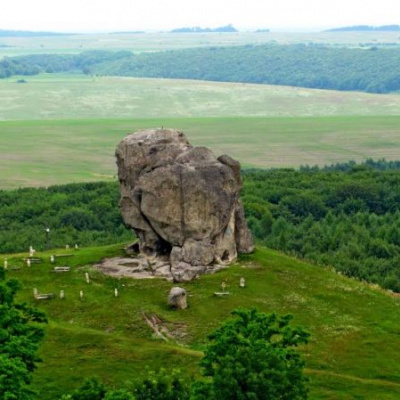The Devil's Stone in Pidkamin is a geological natural monument of local importance. It is a strange geomorphological rock formation with no mountains or any stone embankments nearby, as if someone brought it here. Scientists believe that it is a remnant of a previous geological period. It could once have served as an idol for the locals. There is a heart-shaped depression in the western side. It seems as if rituals used to be performed here.
The height of the stone reaches 16 meters, which is equivalent to a three-story building. There are stone crosses around it - graves with inscriptions scratched on them. There are two caves near the hill where the stone is located. One of them has a tall cross and a blocked entrance. Scientists claim that there was a church and a chapel in these caves. About 200-300 years later, stone was quarried from there for construction.
Since 2007, the Pidkamin ethnographic festival has been regularly held near the stone in August.
One night, a devil took a stone from the Carpathian Mountains and carried it to Pochayiv, as he was overcome with the desire to destroy the monastery. But the road was long, and when the devil reached this hill, the roosters were already crowing. He could not hold the stone and dropped it, and then ran away. It's better not to go to the stone at night - sacrifices used to be made near it, and a cemetery was formed nearby. This is evidenced by the stone crosses that have survived to this day.
According to written sources, 1441 is considered the year of the first mention of the Devil's Stone in Pidkamin. Pidkamin is an energetic, even mystical place. It is an almost twenty-meter high rock that gave the settlement its name. On the rock there are traces of a wooden structure, according to chronicle sources these are traces of an ancient monastery, on the first floor of which there were monks' cells, on the second floor there was a temple. Ancient chronicles also indicate that dead monks were buried on the territory of the monastery, and stone crosses on the graves have survived to this day. The numerous grooves and recesses that held the wooden structures are similar to the construction systems of the Carpathian fortresses of Tustan and Bubnyshche. Research shows that during the period of the Galicia-Volhynia principality, a church was built on the stone, which was primarily defensive in nature.
The first time you hear the name "Pidkamin", you don't have to guess where this name came from. Indeed, the village of Pidkamin in the Brody district of the Lviv region fits comfortably under the so-called Devil's Stone, which has been standing next to the monastery hill since ancient times. Scientists claim that the 16-meter-high Devil's Stone, or Giant Stone, is the remains of the tectonic Holohirsko-Kremenets ridge of the Carpathians. In pagan times, it was used as a temple or altar, and later as a monastery of defensive importance.
Recently, Pidkamin has become known, and even popular among young people, thanks to the festival of the same name, which was held this summer for the seventh time. It traditionally brings together lovers of ethnic culture and folk traditions of the Carpathians. The most convenient way to get here is by car. The village is located 25 kilometers from the district center of Brody (highway P39). The stone can be seen from afar, so you will notice it immediately when you drive up to the village.





